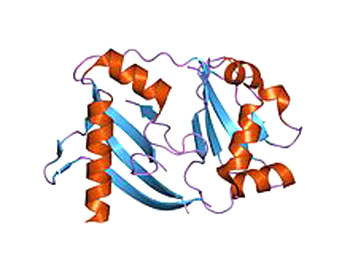Genetic Engineers Use CRISPR/Cas9 to Transform Fibroblasts into Neurons
By LabMedica International staff writers
Posted on 23 Aug 2016
A team of biomedical engineers used precisely controlled CRISPR/Cas9 gene editing to convert mouse embryonic fibroblasts to functional induced neuronal cells.Posted on 23 Aug 2016
Fibroblasts can be transformed into neurons by causing the cells to overexpress three neuron genes, the so-called BAM factors: Brn2, Ascl1, and Myt1l. Previously, viral vectors were used to transport these genes into fibroblasts. While this approach could trigger transformation into neurons, it introduced a considerable amount of undesirable genetic material into the cells.

Image: A representation of the crystal structure of a CRISPR-associated protein (Photo courtesy of Wikimedia Commons).
To avoid this problem, investigators at Duke University (Durham, NC, USA) used the CRISPR/Cas 9 editing technique to activate the BAM factors already present in the fibroblasts.
CRISPRs (clustered regularly interspaced short palindromic repeats) are segments of prokaryotic DNA containing short repetitions of base sequences. Each repetition is followed by short segments of "spacer DNA" from previous exposures to a bacterial virus or plasmid. CRISPRs are found in approximately 40% of sequenced bacteria genomes and 90% of sequenced archaea. CRISPRs are often associated with cas genes that code for proteins related to CRISPRs. Since 2013, the CRISPR/Cas system has been used in research for gene editing (adding, disrupting, or changing the sequence of specific genes) and gene regulation. By delivering the Cas9 enzyme and appropriate guide RNAs into a cell, the organism's genome can be cut at any desired location. The conventional CRISPR/Cas9 system is composed of two parts: the Cas9 enzyme, which cleaves the DNA molecule and specific RNA guides (CRISPRs) that shepherd the Cas9 protein to the target gene on a DNA strand. In the current study, a modified form of CRISPR/Cas9 was employed to activate the target genes rather than remove them.
The investigators reported in the August 11, 2016, online edition of the journal Cell Stem Cell that modified CRISPR/Cas9 gene editing induced activation of the endogenous (BAM factor genes to convert mouse embryonic fibroblasts to induced neuronal cells. This direct activation of endogenous genes rapidly remodeled the epigenetic state of the target loci and induced sustained endogenous gene expression during reprogramming. Thus, transcriptional activation and epigenetic remodeling of endogenous master transcription factors were sufficient for conversion between cell types. Once activated by CRISPR editing, the BAM factor genes robustly activated neuronal genes. This caused the transformed fibroblasts to conduct electrical signals, a characteristic of neuronal cells. After the CRISPR activators disappeared, the cells retained their neuronal properties.
"When blasting cells with master transcription factors made by viruses, it is possible to make cells that behave like neurons," said senior author Dr. Charles Gersbach, professor of biomedical engineering at Duke University. "But if they truly have become autonomously functioning neurons, then they should not require the continuous presence of that external stimulus. This technique has many applications for science and medicine. For example, we might have a general idea of how most people's neurons will respond to a drug, but we do not know how your particular neurons with your particular genetics will respond. Taking biopsies of your brain to test your neurons is not an option. But if we could take a skin cell from your arm, turn it into a neuron, and then treat it with various drug combinations, we could determine an optimal personalized therapy."
"In the future, you can imagine making neurons and implanting them in the brain to treat Parkinson's disease or other neurodegenerative conditions," said Dr. Gersbach. "But even if we do not get that far, you can do a lot with these in the lab to help develop better therapies."
Related Links:
Duke University














